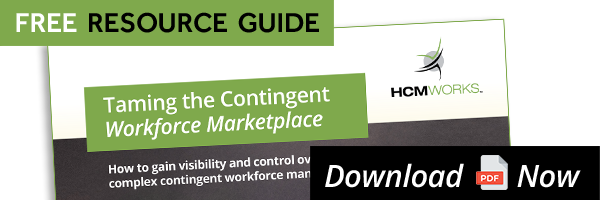More and more organizations are making use of contingent labor as a part of their business strategy - reducing fixed payroll costs, filling gaps in valuable skills, and increasing workforce flexibility, amongst other benefits.
However, while it's important to realize that managing a contingent workforce can be complex, there can also be a number of significant benefits, such as full visibility, flexibility, reduced costs, optimizing performance, risk mitigation and leveraging specialized skills. But managing a contingent workforce also comes with increased risk, and in order to ensure that your business stays within compliance, properly optimizes performance, and doesn’t spend unnecessarily - a contingent workforce solution will need to be implemented.
Here are 3 tips that we recommend you need to successfully and effectively implement a contingent workforce solution.
1 - Evaluate Your Current Workforce Situation
In order to reap the full benefits of any contingent workforce solution, you must take a close look at your current situation.
You'll want to take note of how many contingent workers you have right now, and how you expect this workforce to grow in the future. You'll want to understand your workforce strengths and weaknesses. For example, maybe you have workers who are under-performing. Or, maybe one of your greater risks is not fully understanding worker classification, which could lead to tax fines and other penalties. Maybe you’re spending too much on this workforce and want to better understand how to more efficiently manage them to reduce your costs.
The better you understand your current situation, when it comes to your contingent workforce, the easier it will be to implement the right contingent workforce solutions so you’ll really be able to reap the benefits.
2 - Put Technology To Good Use
Technology should be an essential part of all contingent workforce solutions. There’s just no need to perform tasks manually anymore. Having the right software can automate repetitive tasks which can save costs as well as ensure operations run smoothly reducing the instance of human error.
Contingent labor management software programs can help you monitor, track, manage, and pay your contingent workers in the most efficient way possible. It helps you to maximize productivity, put the best workers where they’re needed most, see opportunities that will allow you to reduce costs, or gain a competitive advantage, increase visibility in order to reduce spend, and anticipate problemsbefore they arise. You’ll be able to make more informed decisions regarding your workforce when you have access to this valuable data.
3 - Work With A Managed Service Provider (MSP)
An MSP is an outsourced third-party company that manages and assumes the responsibility of a defined set of day-to-day management services to its customers.
An MSP is a strategic method of improving operations that is commonplace among large and medium-size corporations, non-profit organizations, educational institutions, hospitals and governments. Using an MSP is also an ideal choice for mid-sized companies that do not have the resources, personnel, or revenue required to effectively manage their contingent workers on their own.
The provider will take over the complex, often repetitive and tedious, and arduous work involved in managing your contingent workforce. You can outsource sourcing, compliance, payroll, and other tasks to a Managed Services Provider.
While you’ll still have managerial control and responsibility for the outsourced operations, you won’t have to do the work alone, and you’ll gain the experience and expertise of the third party professionals to ensure compliance and efficiency.
Working with an MSP can drive cost savings, allow for greater accuracy and efficiency, and reduce your contingent workforce risks and liabilities.
You and your in-house staff should be focused on the tasks that will drive profits and grow your business, not on the minutia of the day-to-day responsibilities of trying to manage a large contingent workforce. Putting these steps into action will help you to mitigate risk, reduce costs and better leverage your flexible workforce.
Want more information on how to effectively implement a contingent workforce solution? Contact a Contingent Workforce Advisor to set up an executive briefing.
Looking for more information about further ways to reduce the risks, costs and complexity of your contingent workforce? Download our latest ebook.
About HCMWorks
We are a contingent workforce service provider helping organizations gain better access to talent through the use of independent contractors, consultants, temporary workers, freelancers and other non-payrolled employees. We provide the expertise, the technology, and processes to help you reduce your workforce costs, mitigate against misclassification and co-employment risks, and increase the efficiency and timeliness of your contingent recruitment process. Read more about what our clients say about us here.



